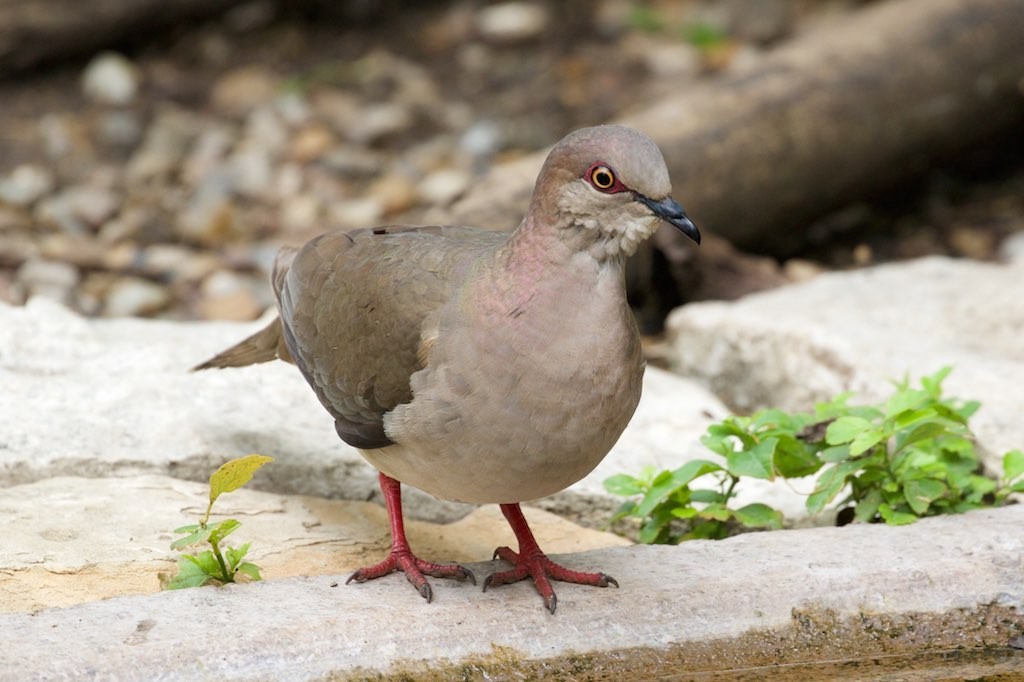White-tipped Dove
A species of White-tipped Doves Scientific name : Leptotila verreauxi Genus : White-tipped Doves
White-tipped Dove, A species of White-tipped Doves
Botanical name: Leptotila verreauxi
Genus: White-tipped Doves
Content
Description People often ask General Info
Description
The dove is about 28 cm (11 in) long and weighs 155 g (5.5 oz). Adult birds of most races have a grey tinge from the crown to the nape, a pale grey or whitish forehead and a whitish throat. The eye-ring is typically red in most of its range, but blue in most of the Amazon and northern South America. The upperparts and wings are grey-brown, and the underparts are whitish shading to pinkish, dull grey or buff on the chest. The underwing coverts are rufous. The tail is broadly tipped with white, but this is best visible from below or in flight. The bill is black, the legs are red and the iris is yellow. The white-tipped dove resembles the closely related grey-fronted dove (Leptotila rufaxilla), which prefers humid forest habitats. The best distinctions are the greyer forehead and crown, which contrast less with the hindcrown than in the grey-fronted dove. In the area of overlap, the white-tipped dove usually has a blue (not red) eye-ring, but this is not reliable in some parts of Brazil, Argentina, Bolivia, Paraguay and Uruguay, where it typically is red in both species. 
Size
25-30 cm (10-12 in)
Colors
Black
Red
Bronze
Gray
White
Life Expectancy
9 years
Nest Placement
Tree
Clutch Size
1 - 3 eggs
Feeding Habits
White-tipped Dove predominantly consumes seeds, fruits, and insects gleaned from the ground or lower vegetation. Notable US dietary items include Texas ebony, cedar elm, and various fruits. They also consume citrus fruits and common grains like milo and corn from feeding stations.
Habitat
White-tipped Dove thrives across diverse woodlands, preferring thick vegetative cover, including scrub and dense forests. Adapted from lowlands to altitudes up to 10,500 feet, these birds are found in native, altered, and human-modified habitats, such as orchards and agricultural lands. Their environment typically features dense vines and vegetation like sabal palms and Texas ebony.
Nest Behavior
White-tipped Dove's nesting is a cooperative endeavor with male and female jointly constructing the nest. Males procure nesting materials while females arrange them.
Nest Characteristics
The nest of white-tipped Dove is a bulky, shallow bowl composed of twigs situated in a forked tree branch, 6–10 feet above ground, typically within Texas ebony, anacua, or spiny hackberry trees. It measures approximately 6 inches in width and 3.5 inches in height.
Dite type
Granivorous
People often ask
General Info
Feeding Habits
Bird food type
Bird Feeder Type

Platform
Sounds
Song
Recording location: Mexico
Behavior
White-tipped Dove exhibit a distinctive blend of behaviors that articulate their interaction with their environment. Typically monogamous, their breeding season in southern Texas spans March to September, displaying courtship intricacies such as males’ low cooing songs during dawn and dusk, as well as peculiar running towards females with a lowered posture before cooing with head pumps. Males may chase females towards chosen nest sites, escalating to preening and bill touching once paired. Aggressive territoriality especially near food sources is common, leading to chasing away intruders. Post-fledging, offspring remain near their birthplace, though adults become solitary and skittish in winter, flushing at disturbances but staying vigilant after short flights.
Distribution Area
The dove is a resident breeder from southernmost Texas in the United States through Mexico and Central America south to western Peru and central Argentina. It also breeds on the offshore islands of northern South America, including Trinidad and Tobago and the Netherlands Antilles. It inhabits scrub, woodland and forest. 
Species Status
Not globally threatened.
Scientific Classification
Phylum
Chordates Class
Birds Order
Pigeons and doves Family
Dove Genus
White-tipped Doves Species
White-tipped Dove 